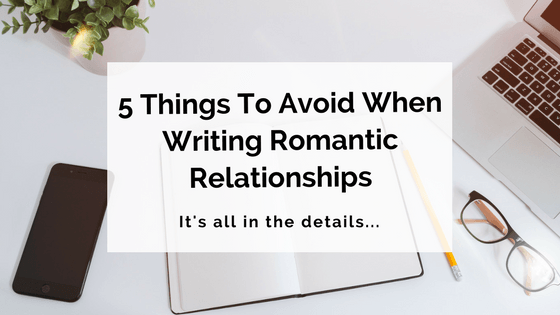Ahh, romance. Not only is it a massively popular genre of its own, it’s also an extremely common element in countless other genres and categories – from literary fiction right through to sci-fi, fantasy and young adult fiction. However, writing romantic relationships isn’t easy. Just because it’s done often, doesn’t mean it’s always done right!

If you’ve ever struggled to write romantic elements, don’t worry, because you definitely aren’t alone. Many authors have trouble crafting authentic relationships between their characters. Even the most seasoned writers are at risk of falling prey to clichés, stereotypical character tropes, and love stories that don’t quite ring true…
So whether you’re writing a romance novel or a book in any other genre that contains elements of romance, read on for five key things to avoid when writing romantic relationships.
1. Forgetting about conflict and tension
Conflict and tension are the elements that keep all stories moving. They draw readers in, get them invested in the story and the characters, and keep them turning pages.
This is no different when it comes to writing romantic relationships. The build-up of tension, and even outright initial conflict, between two people who are attracted to each other is a huge part of what many readers love about romance.
However, there are actually two potential mistakes to be made here:
- Not maintaining conflict and tension in other aspects of the story apart from the romance.
- Not keeping conflict and tension present after characters end up together.
In the first instance, you might be writing a story in which there’s a great amount of plot-pushing conflict and sizzling tension between your two romantically inclined characters. But in putting so much effort into the romantic conflict and tension, you might have forgotten to inject these elements anywhere else in the story.
Now, this can be more easily forgivable if you’re writing strictly within the romance genre. After all, the relationship, its development and all its ups and downs are what romance readers are here for. But do keep in mind that there needs to be other story elements as well, and that they should involve some measure of conflict to keep the story moving.
If you’re writing romantic relationships within genres other than romance, however, you need to be especially careful to keep up the conflict and tension in your story’s other areas.
Always remember which genre you’re primarily writing in, and who your target market is.

If you’re writing fantasy or one of its subgenres, for example, by all means weave a romantic element throughout. But keep in mind that the majority of your conflict and tension should come from the other aspects of your story, such as magic, politics or a character’s quest.
(If you find yourself focusing more and more on the romantic aspects of your writing to the detriment of other plot points, perhaps it’s time to reconsider which genre you really want to be writing in after all!)
The second potential mistake to be made is building up to the climactic point in which two characters finally end up together – and then instantly forgetting about conflict and tension altogether.
It’s all well and good to get caught up in developing the build-up to a romantic relationship; as we said before, that’s a favourite aspect of romance for many readers. However, it’s important to keep that all-important conflict and tension running through your story even after your characters get together.
Remember that in real life, no relationship is perfect. No fictional relationship should be perfect, either.
And even if your characters are pretty damn happy now they’re together, there still has to be some type of conflict throughout the story that will affect them – both individually and as a couple.

2. Creating stereotypical characters
Stereotypical characters are found in every genre and style of book. But unfortunately, they’re a little more likely to appear wherever romance is involved.
You’ve no doubt come across some pretty unbelievable, cringeworthy or two-dimensional characters in a romance novel, romantic comedy movie, or any other story with romantic elements.
Whether it’s the broody, sulking man with a troubled past and a soft heart, the manic pixie dream girl, or simply a ‘Mary Sue’-style character, there are countless stereotypes and overdone character tropes perpetuated through romance in literature.
Luckily, there’s an easy way to avoid this! You just need to keep the following in mind at all times:
When writing romantic relationships, each character needs to be developed individually as well as in terms of their relationship.
Crafting believable characters is one of the most important aspects of fiction writing. If you can’t make each character authentic on their own, the relationship they share won’t be authentic either.
To create great romantic relationships, you first need to create great individual characters. They need to be flawed, complex and real in order to resonate with readers. None of these perfect cookie-cutter characters who lack any real substance, or who exist primarily for the sake of a romantic story element!
If you develop fully rounded, engaging and believable characters, it’s much easier to develop fully rounded, engaging and believable relationships between them. Simple.

3. Writing ‘love at first sight’
This is, of course, one of the biggest no-nos when writing romantic relationships.
We’ve spoken before about ‘instalove’ as one of the most common mistakes to avoid when writing YA fiction, and it’s no different when it comes to writing for adults.
In real life, nobody meets (or even just looks at) someone for the first time and immediately falls in love. Yes, there can be instant attraction – but this shouldn’t be confused with instant love.
Even if your romantic relationship is just a subplot in your story, that’s no excuse for it not to be developed properly. And besides, doesn’t establishing the romance instantly take all the fun, tension and anticipation out of the build-up we talked about above?!
No matter which genre you write in, your readers want to go on a journey with your characters, and this includes the building of their relationships.
There’s no faster way to make readers’ eyes roll than two characters falling instantly in love without any real interaction or meaningful connection. So be sure to avoid this trope at all costs.

4. Romanticising harmful relationship elements
When writing romantic relationships in your novels, it’s extremely important to distinguish between what’s healthy in a relationship, and what’s harmful.
We’re not saying every relationship you write has to be a perfectly healthy and happy one. (See our notes on conflict and tension above!) We’re simply saying that you need to be aware when you’re writing romantic elements that are actually harmful, and that you need to avoid romanticising these elements at all costs.
So what do we mean when we refer to ‘harmful’ relationship elements?
Basically, we’re talking about any aspects of a relationship that are portrayed as ‘romantic’ or even an expression of ‘true love’, but are actually unhealthy or even abusive.
Think about some of the romance stories portrayed in books, films and TV today. How many emotionally, verbally or even physically abusive characters are out there masquerading as romantic ‘heroes’? How many unhealthy relationship aspects and negative character traits have been passed off as ‘sexy’ or ‘desirable’? (Yes, Fifty Shades of Grey, we’re looking at you.)
Common character traits along these lines include:
- Jealousy
- Possessiveness/overprotectiveness
- Dominant/controlling personality
- Obsessiveness/desperation
Again, we’re not saying you can’t create characters who have these traits, or that you can’t write about an abusive or toxic relationship.
We’re saying that if you do, you need to avoid romanticising those aspects, and always make it clear that this is not what a normal, healthy relationship actually looks like.

5. Using clichéd language and descriptions
If any element of fiction is in the most danger of being rife with clichés, it has to be romance!
Just like the stereotypical character tropes we talked about above, the language and descriptions you use when writing romantic relationships are at risk of falling into clichéd territory.
Whether you’re writing sex scenes, or simply describing the way characters see each other or feel when they’re around each other, there’s a lot of language that tends to be overused in romance writing. This includes things like:
- Describing eyes in great detail (especially their colour and depth)
- Pulses racing/hearts beating faster
- Gazes/intense stares
- Clichéd comparisons, especially to nature/celestial bodies – ‘Her eyes were like stars’, ‘She shone like the sun’, and so on
- Words like ‘love’, ‘passion’, ‘desire’ etc.
Try to think outside the box a little when it comes to describing your characters’ feelings. What fresh or unusual imagery can you use to evoke the nuances of their relationship? How can you tie this imagery in with who they are as a character?
Experiment with words, but also remember that sometimes keeping things simple can be the most effective way of writing romantic relationships.

***
What are your best tips for writing romantic relationships? How do you develop a sense of authenticity between your characters? What are your favourite examples of well-written love stories and relationships?
Let us know in the comments!
11 responses to “5 Things To Avoid When Writing Romantic Relationships”
The classic Pride and Prejudice 🙂
I write historical fiction. Bah humbug, I say to romance . . . except I needed to incorporate some into my storyline.
Good advice!
Thanks
MM
Thanks for stopping by, Michael! Hopefully the article might help you incorporate that dreaded romance into your story 😉
Interesting post and good reminders (especially for YA).
Thank you.
No worries, Sally! Glad you liked the post 🙂
Clear and relevant, as ever. Worth reading through even if you already know it.
People are always in relationships, not just romantic ones. A romantic relationship may colour all others, but they are still there, and are the structure of your character’s world. Your character may forget this in the heat of passion, but you as the writer must not.
“Unhealthy” relationships may well endure. Indeed it may be the dark side of them that keeps them going, and makes them worth writing about. Don’t pretend that dark is light, do portray such relationships honestly, however much you would like to find a way to make them “healthy”. If that’s where the story goes, go there.
Great advice, Andy! Totally agree with all your points 🙂
Great post! My personal gripe is with heroines who are submissive, lacking life experience, and waiting around for a forceful, charismatic hero to come and rescue them. Bleccch!
If you’re looking for a smart, funny romance instead, try Remedial Rocket Science by Susannah Nix, or Accidental Tryst by Natasha Boyd. They both have likeable characters with other things going on in their lives apart from the love story.
Great advice, Claire! I’m writing an historical novel with a strong romantic plot and I’ve found that I have the most trouble keeping the conflict going. Also, that whole love at first sight thing – ha! Thanks for reminding us of all of these things to avoid. 🙂
Thanks for stopping by, Cassandra! Glad you enjoyed the article. 🙂 Best of luck with your historical novel – if you dig deep into your characters’ motivations and personalities, I’m sure you’ll have no trouble keeping that conflict simmering throughout!
I love this list! Thanks a lot! Especially the harmful elements.